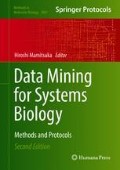Abstract
Detecting combinatorial effects is important to various research areas, including biology, genomics, and medical sciences. However, this task was not only computationally nontrivial but also extremely difficult to achieve because of the necessity of a multiple testing procedure; hence few methods can comprehensively analyze high-order combinations. Recently, Limitless Arity Multiple-testing Procedure (LAMP) was introduced, allowing us to enumerate statistically significant combinations from a given dataset. This chapter provides instructions for LAMP using simple examples of combinatorial transcription factor regulation discovery and visualization of the results. This chapter also introduces LAMPLINK, which is extended software of LAMP. LAMPLINK can handle genetic dataset to detect statistically significant interactions among multiple SNPs from a genome-wide association study (GWAS) dataset.
Access this chapter
Tax calculation will be finalised at checkout
Purchases are for personal use only
References
Baudry A, Heim MA, Dubreucq B et al (2004) TT2, TT8, and TTG1 synergistically specify the expression of BANYULS and proanthocyanidin biosynthesis in Arabidopsis thaliana. Plant J 39:366–380
Schlesinger J, Schueler M, Grunert M et al (2011) The cardiac transcription network modulated by Gata4, Mef2a, Nkx2.5, Srf, histone modifications, and microRNAs. PLoS Genet 7:e1001313
Carlborg O, Haley CS (2004) Epistasis: too often neglected in complex trait studies? Nat Rev Genet 5:618–625
Phillips PC (2008) Epistasis--the essential role of gene interactions in the structure and evolution of genetic systems. Nat Rev Genet 9:855–867
Noble WS (2009) How does multiple testing correction work? Nat Biotechnol 27:1135–1137
Bonferroni CE (1936) Teoria statistica delle classi e calcolo delle probabilità. Pubbl del R Ist Super di Sci Econ e Commer di Firenze 8:3–62
Terada A, Okada-hatakeyama M, Tsuda K, Sese J (2013) Statistical significance of combinatorial regulations. Proc Natl Acad Sci U S A 110:12996–13001
Terada A, Tsuda K, Sese J (2013) Fast Westfall-Young permutation procedure for combinatorial regulation discovery. In: 2013 IEEE International Conference on Bioinformatics and Biomedicine. pp 153–158
Sugiyama M, López FL, Kasenburg N, Borgwardt KM (2015) Significant subgraph mining with multiple testing correction. In: 2015 SIAM International Conference on Data Mining. pp 37–45
Llinares-López F, Sugiyama M, Papaxanthos L, Borgwardt K (2015) Fast and memory-efficient significant pattern mining via permutation testing. In: Proceedings of the 21th ACM SIGKDD International Conference on Knowledge Discovery and Data Mining. pp 725–734
Terada A, Yamada R, Tsuda K, Sese J (2016) LAMPLINK: detection of statistically significant SNP combinations from GWAS data. Bioinformatics 32:3513–3515
Uno T, Asai T, Uchida Y, Arimura H (2003) LCM: an efficient algorithm for enumerating frequent closed item sets. In: Workshop on Frequent Itemset Mining Implementations (FIMI’03)
Purcell S, Neale B, Todd-Brown K et al (2007) PLINK: a tool set for whole-genome association and population-based linkage analyses. Am J Hum Genet 81:559–575
Author information
Authors and Affiliations
Corresponding authors
Editor information
Editors and Affiliations
Rights and permissions
Copyright information
© 2018 Springer Science+Business Media, LLC, part of Springer Nature
About this protocol
Cite this protocol
Terada, A., Tsuda, K. (2018). Multiple Testing Tool to Detect Combinatorial Effects in Biology. In: Mamitsuka, H. (eds) Data Mining for Systems Biology. Methods in Molecular Biology, vol 1807. Humana Press, New York, NY. https://doi.org/10.1007/978-1-4939-8561-6_7
Download citation
DOI: https://doi.org/10.1007/978-1-4939-8561-6_7
Published:
Publisher Name: Humana Press, New York, NY
Print ISBN: 978-1-4939-8560-9
Online ISBN: 978-1-4939-8561-6
eBook Packages: Springer Protocols

